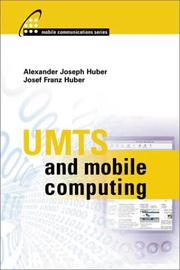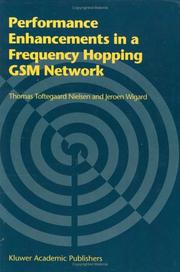| Listing 11 - 19 of 19 | << page >> |
Sort by
|
Book
ISBN: 1580534252 9781580534253 Year: 1998 Publisher: Boston Artech House
Abstract | Keywords | Export | Availability | Bookmark
 Loading...
Loading...Choose an application
- Reference Manager
- EndNote
- RefWorks (Direct export to RefWorks)
Global system for mobile communications --- Personal communication service systems --- Electrical & Computer Engineering --- Engineering & Applied Sciences --- Telecommunications --- PCS systems --- Personal telecommunication systems --- Personal wireless communication systems --- Personalized communication services --- Wireless personal communication systems --- Wireless communication systems --- GSM communications --- Cell phone systems --- Context-aware computing

ISBN: 1580535631 9781580535632 9781580532648 1580532640 Year: 2002 Publisher: Boston Artech House
Abstract | Keywords | Export | Availability | Bookmark
 Loading...
Loading...Choose an application
- Reference Manager
- EndNote
- RefWorks (Direct export to RefWorks)
Annotation This unique book bridges the gap between ubiquitous computing (UBICOMP) and third generation mobile communication. A first-of-its-kind, this resource helps you decide which are the most promising technologies to use for specific mobile communication applications. Scenarios indicate how new applications will be developed and how to implement them. It points out each technology's distinguishing characteristics, advantages and disadvantages, to help you determine if a certain implementation is feasible and what performance level you might expect.
Mobile communication systems. --- Wireless communication systems. --- Global system for mobile communications. --- GSM communications --- Cell phone systems --- Context-aware computing --- Communication systems, Wireless --- Wireless data communication systems --- Wireless information networks --- Wireless telecommunication systems --- Telecommunication systems --- Vehicles --- Vehicular communication systems --- Radio --- Wireless communication systems --- Communication systems
Book
ISBN: 1611225094 9781611225099 9781607416616 1607416611 Year: 2010 Publisher: New York
Abstract | Keywords | Export | Availability | Bookmark
 Loading...
Loading...Choose an application
- Reference Manager
- EndNote
- RefWorks (Direct export to RefWorks)
Java (Computer program language) --- Embedded computer systems --- Bluetooth technology. --- Global system for mobile communications. --- Global Positioning System. --- Global Navigation Satellite System --- GNSS (Navigational system) --- GPS (Navigational system) --- Navigation Satellite Timing and Ranging Global Positioning System --- NAVSTAR GPS --- Artificial satellites in navigation --- Mobile geographic information systems --- GSM communications --- Cell phone systems --- Context-aware computing --- Wireless communication systems --- Object-oriented programming languages --- JavaSpaces technology --- Programming.
Book
ISBN: 9780128127087 0128127082 0128127074 9780128127070 1119333954 Year: 2018 Publisher: London, United Kingdom : Academic Press, an imprint of Elsevier,
Abstract | Keywords | Export | Availability | Bookmark
 Loading...
Loading...Choose an application
- Reference Manager
- EndNote
- RefWorks (Direct export to RefWorks)
Mobile communication systems. --- Wireless communication systems. --- Global system for mobile communications. --- GSM communications --- Cell phone systems --- Context-aware computing --- Communication systems, Wireless --- Wireless data communication systems --- Wireless information networks --- Wireless telecommunication systems --- Telecommunication systems --- Vehicles --- Vehicular communication systems --- Radio --- Wireless communication systems --- Communication systems

ISBN: 142372349X 9781423723493 9780750677462 0750677465 9786611009755 128100975X 0080476317 9781281009753 9780080476315 Year: 2005 Publisher: Amsterdam Boston Elsevier :Newnes
Abstract | Keywords | Export | Availability | Bookmark
 Loading...
Loading...Choose an application
- Reference Manager
- EndNote
- RefWorks (Direct export to RefWorks)
Finally--a single volume guide to really effective security for both voice and data wireless networks!More and more data and voice communications are going via wireless at some point between the sender and intended recipient. As a result, truly ""bulletproof"" wireless security is now more than a desirable feature--instead, it's a necessity to protect essential personal and business data from hackers and eavesdroppers.In this handy reference, Praphul Chandra gives you the conceptual and practical tools every RF, wireless, and network engineer needs for high-security wireless ap
Information Technology --- General and Others --- Wireless communication systems --- Wireless LANs --- Global system for mobile communications --- Universal Mobile Telecommunications System --- IEEE 802.11 (Standard) --- Security measures. --- 802.11 (Standard) --- Wi-Fi systems --- WiFi systems --- Wireless Fidelity --- Ethernet (Local area network system) --- UMTS (Telecommunication) --- Cell phone systems --- GSM communications --- Context-aware computing --- Standards

ISBN: 128020611X 9786610206117 0306470454 0792383516 Year: 1999 Publisher: Boston, Massachusetts : Kluwer Academic Publishers,
Abstract | Keywords | Export | Availability | Bookmark
 Loading...
Loading...Choose an application
- Reference Manager
- EndNote
- RefWorks (Direct export to RefWorks)
The Global System for Mobile Communication (GSM) is undoubtedly the most successful second generation digital mobile radio system. One of the key factors for this exceptional performance is the constant evolution of the GSM systems and its derivatives DCS-1800 and PCS-1900. The objective of the book is to address new concepts in the GSM system, dealing with both standardised features as well as theoretically and technologically feasible improvements, which contribute to evolutionary changes in general. Dynamic evolution of GSM presents a platform for the Universal Mobile Telecommunication System (UMTS) introduction and major trends in UMTS development will be addressed in this book, in particular progress towards new radio interface. The book is the collection of individual contributions from a number of authors. The intention of the editors was to gather the most prominent specialist in the GSM area. Ongoing efforts in GSM standardisation are focused on Phase 2+ with items planned to be added gradually on demand. Being mostly independent of each other, each of them could be introduced with little impact on the rest of the system. Speech remains the prime service of cellular systems with ongoing work on spectral efficiency taking into account the trade-off between cost of the system and transmission quality. Most notable result from novel speech service implementations is the introduction of new Enhanced Full Rate (EFR) speech coder. International railway organisation (Union Internationale des Chemins de Fer - UIC) has influenced the development of Advanced Speech Call Items (ASCI).
Global system for mobile communications. --- Cell phone systems. --- Telecommunication. --- Computer engineering. --- Computer Communication Networks. --- Communications Engineering, Networks. --- Electrical Engineering. --- Electrical engineering. --- Computer communication systems. --- Communication systems, Computer --- Computer communication systems --- Data networks, Computer --- ECNs (Electronic communication networks) --- Electronic communication networks --- Networks, Computer --- Teleprocessing networks --- Data transmission systems --- Digital communications --- Electronic systems --- Information networks --- Telecommunication --- Cyberinfrastructure --- Electronic data processing --- Network computers --- Electric engineering --- Engineering --- Distributed processing --- GSM communications --- Cell phone systems --- Context-aware computing

ISBN: 0792378199 9786610207961 1280207965 0306473135 Year: 2002 Publisher: New York : Kluwer Academic Publishers,
Abstract | Keywords | Export | Availability | Bookmark
 Loading...
Loading...Choose an application
- Reference Manager
- EndNote
- RefWorks (Direct export to RefWorks)
Due to the explosive global growth in the number of mobile subscribers, as well as the growth predicted in the mobile data segment, the need for improved spectrum efficiency on the radio interface becomes more and more important. Frequency hopping (FH) is an effective method for improving the spectrum efficiency. One of the advantages of FH is that it can be combined with other spectral efficiency improving features like power control, handover and reuse partitioning. Performance Enhancements in a Frequency Hopping GSM Network covers FH and some of the additional features in detail. It begins with an in-depth description of the basic concept of FH on link level as well as on system level. Different methods have been used for analysis, such as link level simulations, network level simulations and classic tele-traffic theory. Special features of Performance Enhancements in a Frequency Hopping GSM Network: Combines the practical experiences of operator and vendor with more theoretical research methods. An in-depth treatment of prevailing problems in GSM networks; Presentation of a new method, computer-aided network design (CAND), which has been developed to analyse the complex network structures of a GSM network. CAND provides the possibility for more realistic performance evaluations than conventional methods; Provides GSM-specific analysis of functionality improvements in power control, discontinuous transmission, and several handover algorithms; Explanation of the quality and capacity gains of features like the combination of FH and reuse partitioning, referred to as intelligent frequency hopping; A frequency planning method for FH GSM networks is presented. This method exploits the benefits from FH directly in the allocation process, increasing the overall frequency plan.
Gsm's --- Electrical engineering. --- Data structures (Computer science). --- Computer communication systems. --- Electrical Engineering. --- Data Structures and Information Theory. --- Computer Communication Networks. --- Communication systems, Computer --- Computer communication systems --- Data networks, Computer --- ECNs (Electronic communication networks) --- Electronic communication networks --- Networks, Computer --- Teleprocessing networks --- Data transmission systems --- Digital communications --- Electronic systems --- Information networks --- Telecommunication --- Cyberinfrastructure --- Electronic data processing --- Network computers --- Information structures (Computer science) --- Structures, Data (Computer science) --- Structures, Information (Computer science) --- File organization (Computer science) --- Abstract data types (Computer science) --- Electric engineering --- Engineering --- Distributed processing --- Global system for mobile communications. --- GSM communications --- Cell phone systems --- Context-aware computing
Book
ISBN: 9783834892607 3834806978 9783834806970 3834892602 Year: 2008 Publisher: Weisbaden : Vieweg+Teubner Research,
Abstract | Keywords | Export | Availability | Bookmark
 Loading...
Loading...Choose an application
- Reference Manager
- EndNote
- RefWorks (Direct export to RefWorks)
Interference determines the performance of UMTS radio networks. In order to provide good coverage and high capacity, network operators need to control the effects and dynamics of interference coupling among users and cells. This is a major challenge in planning and optimizing UMTS radio networks. Hans-Florian Geerdes establishes a concise system model, which describes interference coupling and its impact on the network. The system model enables an efficient analysis of radio network performance. It is also the basis for new automatic planning algorithms. Extensive computational experiments on realistic data demonstrate that the presented evaluation and optimization methods are well-suited tools for use in practice.
Computer Science. --- Computer Science, general. --- Computer science. --- Informatique --- Information Technology --- Computer Science (Hardware & Networks) --- Mobile communication systems. --- Multimedia systems. --- Universal Mobile Telecommunications System. --- Wireless communication systems. --- Electrical & Computer Engineering --- Engineering & Applied Sciences --- Telecommunications --- Computer Science --- Global system for mobile communications. --- GSM communications --- UMTS (Telecommunication) --- Computer communication systems. --- Electrical engineering. --- Computer Communication Networks. --- Communications Engineering, Networks. --- Cell phone systems --- Context-aware computing --- Telecommunication. --- Informatics --- Science --- Electric communication --- Mass communication --- Telecom --- Telecommunication industry --- Communication --- Information theory --- Telecommuting --- Electric engineering --- Engineering --- Communication systems, Computer --- Computer communication systems --- Data networks, Computer --- ECNs (Electronic communication networks) --- Electronic communication networks --- Networks, Computer --- Teleprocessing networks --- Data transmission systems --- Digital communications --- Electronic systems --- Information networks --- Telecommunication --- Cyberinfrastructure --- Electronic data processing --- Network computers --- Distributed processing
Book
ISBN: 3319428098 331942808X Year: 2017 Publisher: Cham : Springer International Publishing : Imprint: Springer,
Abstract | Keywords | Export | Availability | Bookmark
 Loading...
Loading...Choose an application
- Reference Manager
- EndNote
- RefWorks (Direct export to RefWorks)
This book discusses new, efficient and hardware realizable algorithms that can attain the performance of beyond 5G wireless communication. The authors explain topics gradually, stepping from basic MIMO detection to optimized schemes for both hard and soft domain MIMO detection and also to the feasible VLSI implementation, scalable to any MIMO configuration (including massive MIMO, used in satellite/space communication). The techniques described in this book enable readers to implement real designs, with reduced computational complexity and improved performance.
Engineering. --- Electronics. --- Microelectronics. --- Electronic circuits. --- Signal, Image and Speech Processing. --- Circuits and Systems. --- Electronics and Microelectronics, Instrumentation. --- MIMO systems. --- Global system for mobile communications. --- Mobile communication systems --- Wireless communication systems. --- Standards. --- Communication systems, Wireless --- Wireless data communication systems --- Wireless information networks --- Wireless telecommunication systems --- Vehicles --- Vehicular communication systems --- GSM communications --- Multiple input-multiple output systems --- Communication systems --- Electron-tube circuits --- Electric circuits --- Electron tubes --- Electronics --- Microminiature electronic equipment --- Microminiaturization (Electronics) --- Microtechnology --- Semiconductors --- Miniature electronic equipment --- Electrical engineering --- Physical sciences --- Construction --- Industrial arts --- Technology --- Telecommunication systems --- Radio --- Wireless communication systems --- Cell phone systems --- Context-aware computing --- Systems engineering. --- Engineering systems --- System engineering --- Engineering --- Industrial engineering --- System analysis --- Design and construction --- Signal processing. --- Image processing. --- Speech processing systems. --- Computational linguistics --- Electronic systems --- Information theory --- Modulation theory --- Oral communication --- Speech --- Telecommunication --- Singing voice synthesizers --- Pictorial data processing --- Picture processing --- Processing, Image --- Imaging systems --- Optical data processing --- Processing, Signal --- Information measurement --- Signal theory (Telecommunication)
| Listing 11 - 19 of 19 | << page >> |
Sort by
|

 Search
Search Feedback
Feedback About UniCat
About UniCat  Help
Help News
News